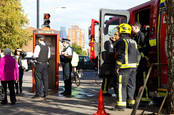This article is more than 1 year old
Home Office cops an earful for emergency network feck-ups - £3bn overbudget and 3 years late
Red warning light for blue-light comms
A National Audit Office report into the unending nightmare of Home Office attempts to buy a new critical communications network has warned the project is likely to be three years late and £3bn over-budget.
Originally due to be switched on in 2017, it is now hoped to be ready to go live in December 2022. This means a £1.4bn extension to Motorola's Airwave contracts. The network is now expected to cost £9.3bn, up 49 per cent on first estimates.
The NAO looked at the Home Office "reset" of the project carried out in 2018. This introduced a phased introduction of ESN, but the NAO notes the revisions of contracts required by this change are still being negotiated by civil servants.
The main contracts with EE and Motorola were meant to be signed in December last year. We are now told they will be signed this month. The NAO notes that until the contracts are signed, the Home Office cannot effectively control its suppliers or hold them to account.
The Emergency Services Network is meant to provide 107 police, fire and ambulance services in England, Scotland and Wales with a full replacement for radio-based Airwave. Additionally, it is hoped, the 4G-based network will allow users to take advantage of high-speed mobile data and related applications all at a lower cost than Airwave.
The Home Office said it still hopes to achieve savings with the move. It reckoned it costs £1.7m a day to run the Airwave network while ESN will cost just £700,000. Break-even point is now expected in July 2029 – seven years later than originally predicted.
Yep: Still not clear how moving parts of ESN will work together
The NAO noted continuing risks including the lack of real world testing for key parts of ESN and the danger that these will not be available in time for roll-out.
The body, which scrutinises the way Parliament spends taxpayers money, warned it was still not clear how the different parts of ESN will work together. It said the original contracts were not clear enough and that changes made since have left the Home Office with responsibility for "doing and assuring this technical work".
"The Home Office has established a new technical working group and, at the time of writing this report, was developing plans for how it will integrate and test ESN", the NAO said.... so that's all good then.
The Home Office expects a contract for programme delivery and advisory services, in "mid-2019", to solve this problem.
Push-to-talk and handset-to-handset communication where the network fails or does not reach are two other stumbling blocks. Motorola bought Kodiak to improve its push-to-talk function but the system still requires development and "will not meet user requirements until 2020 at the earliest", according to the report.
The network also has to work in the London Underground and within buildings. Other functions – like air-to-ground comms – are yet to be awarded. Users are also concerned how the network will function in the event of a power cut.
Rather than offer the gig to one company, the decision was made early on to split it up in order to encourage competition and avoid giving one vendor too much control. In reality, bidders opted out at an early stage leaving the Home Office with only one bid to consider for parts of the mega-contract.
EE won the deal to provide priority access to its network and increase coverage. Motorola Solutions is providing software and systems and KBR Ltd is the integrator. Samsung is developing the handsets and Vodafone is providing the technology to link ESN to control rooms.
The Public Accounts Committee hauled the Home Office over the coals late last year for losing control of the project.
The Home Office sent us the following statement: "The Emergency Services Network (ESN) is on track to deliver an ambitious, world-leading, digital communications network for the emergency services by 2022, resulting in savings of £200m a year.
"It is already allowing people to make 999 calls from areas where it was previously impossible, with almost 400 new masts built so far in some of the most remote areas of Britain.
"When fully implemented, its mobile technology and infrastructure will transform the emergency response of police officers, fire fighters and ambulance crews. This will result in faster and better treatment for victims, including by allowing first responders to transmit footage of crime and accident scenes back to specialists in hospitals and police stations."
The NAO report is available here (PDF). ®


